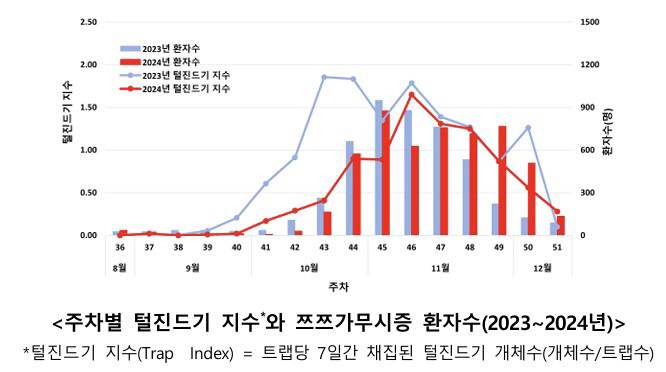When Tsutsugamushi is in vogue...What are the rules to follow for prevention and early treatment?
Aug 27, 2025
|
Tsutsugamushi is a disease that is infected by being bitten by larvae of hairy mites with Orientia tsutsugamushi, and about 6,000 patients are reported annually. In particular, it occurs intensively in October and November. Incidents increased sharply in mid-October (Week 43) and reached their peak in early November (Week 46).
It usually occurs acutely after an incubation period of less than 10 days, and headaches, fever, chills, vomiting, rash, muscle aches, and cough appear, and a crust (black scab, eschar) is formed at the site of the bite of the hair mite larvae. Although it recovers relatively easily when treated with appropriate antibiotics in the early stages of infection, it is easy to miss the treatment period by mistaking it for a simple cold, so if you have symptoms in the fall, you should visit a medical institution immediately for rapid diagnosis and treatment.
Currently, a total of eight types of hair mites that mediate tsutsugamushi in Korea have been reported, including the active hair mite, the large leaf hair mite, the beard hair mite, the oriental hair mite, the semi-hair mite, the four-hair mite, the Joseon bat hair mite, and the multi-occurrence type (dominant species) varies by region. As a result of monitoring in 2024, it was confirmed that a large number of active-leaf hair mites occurred mainly in the southern region and in the central and northern regions.
The timing of larval development varies according to the type of hair mite. In the case of large leaf hair mites and active hair mites, they start to occur in late September and occur most often in late October and early November, while beard hair mites start to occur in late October and tend to persist until late autumn (mid-November and late November).
Fur mites spawn in summer, and larvae that wake up from eggs start to appear in early fall (late September to early October), and the incidence increases rapidly in late fall (mid-October). Most of the hair mites live freely, but during the larval period, they have a habit of being parasitic on animals or humans and growing by ingesting body fluids, so the occurrence of patients is also concentrated during this period.
In this regard, the Korea Centers for Disease Control and Prevention announced that it will conduct monitoring of the occurrence density of hair mites at 19 locations nationwide from August 27 to December 17 (16 weeks).
The Korea Centers for Disease Control and Prevention collaborates with the Honam Disease Response Center, three city and provincial health and environment researchers (Gangwon, Jeonbuk Special Self-Governing Province, Jeollanam-do), and eight climate change medium monitoring centers (eight locations) to identify and analyze the occurrence of hair mites every week using a collector in environments that are likely to come into contact with people such as rice paddies, fields, grasslands, and waterways. Fur mite monitoring information is provided to the public every week through the infectious disease portal on the Korea Centers for Disease Control and Prevention's website.
Director of the Korea Centers for Disease Control and Prevention Lim Seung-kwan said, `As the activity of hair mite larvae increases during autumn harvest and autumn leaves season, the risk of contact with humans increases, so avoid exposure to dangerous environments, wear appropriate work clothes (long sleeves, long pants, gloves, etc.) during agricultural work and outdoor activities, and follow personal precautions to prevent infection with tsutsugamushi, such as showering and washing after outdoor activities," he said. It is important to detect and treat tsutsugamushi early because it can be cured when treated early. If a hair mite bite mark (skin) is found after outdoor activities, or symptoms such as fever and rash appear within 10 days, suspect tsutsugamushi and visit a medical institution immediately for treatment, he stressed.
This article was translated by Naver AI translator.














